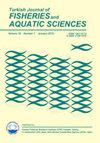防污生物复合材料的制备及理化性能研究壳聚糖和氧化锌对海洋生物污染的防治作用
IF 1.7
4区 农林科学
Q3 FISHERIES
引用次数: 0
摘要
附着生物污垢的有机体会产生各种各样的问题。已经努力探索海洋生物防污材料的来源,但主要是不可培养的;它的工作效率取决于温度、pH、浓度和无效暴露时间。因此,有必要通过开发壳聚糖-氧化锌防污生物复合材料来探索防污材料的新来源。本研究旨在确定壳聚糖和ZnO浓度差异对生物复合材料表征的影响。本研究包括三个阶段:1)壳聚糖和氧化锌的表征;2) 壳聚糖-氧化锌生物复合材料的制备与表征;和3)防污活性测试。结果表明,壳聚糖完全溶于2%的乙酸,粘度为76.4至79.6%,含水量为10.92%,灰分为1.92%,氮含量为3.70%,脱乙酰度为85%。本研究中使用的ZnO具有396.1-458.7nm的颗粒尺寸。生物复合材料的特性表明,壳聚糖1%-ZnO0.6g的溶胀度为0.31%,膜溶解度为0.18%,疏水性为104.50°,附着力为4.50MPa,是最佳的处理方法。防污试验结果表明,壳聚糖1%-ZnO0.6g处理的生物污垢比其他处理少。本文章由计算机程序翻译,如有差异,请以英文原文为准。
Production and Physicochemical Characterization of Antifouling Biocomposites; The Effect of Chitosan and ZnO to Prevent Marine Biofouling
Adhesion of biofouling organism creates various problems. Efforts to explore the source of the antifouling material from marine organisms have been carried out, but it is non-cultivable mainly; its work efficiency depends on temperature, pH, concentration, and ineffective exposure time. Therefore, it is necessary to explore new sources of antifouling material by developing antifouling biocomposites from chitosan-ZnO. This study aims to determine the effect of differences in concentration of chitosan and ZnO on biocomposite characterization. This study consisted of 3 stages, 1) characterization of chitosan and ZnO; 2) production and characterization of chitosan-ZnO biocomposite; and 3) antifouling activity testing. The results showed that chitosan was completely soluble in 2% acetic acid with a viscosity of 76.4 to 79.6%, a water content of 10.92%, ash of 1.92%, nitrogen of 3.70%, and a deacetylation level of 85%. The ZnO used in this study had a particle size of 396.1-458.7 nm. Biocomposite characteristics indicated that the best treatment was chitosan 1% -ZnO 0.6 g with 0.31% swelling, 0.18% solubility film, 104.50° hydrophobic and 4.50 MPa adhesion. The results of the anti-fouling tests showed that the treatment of chitosan 1% -ZnO 0.6 g had less biofouling than other treatments.
求助全文
通过发布文献求助,成功后即可免费获取论文全文。
去求助
来源期刊

Turkish Journal of Fisheries and Aquatic Sciences
FISHERIES-MARINE & FRESHWATER BIOLOGY
CiteScore
3.10
自引率
0.00%
发文量
43
审稿时长
3 months
期刊介绍:
Turkish Journal of Fisheries and Aquatic Sciences" (TrJFAS) is a refereed academic journal has been published by Central Fisheries Research Institute of Turkey and Japan International Cooperation Agency (JICA), and published in English.
It aims to address research and needs of all working and studying within the many varied areas of fisheries and aquatic sciences.
The Journal publishes English language original research papers, critical review articles, short communications and technical notes on applied or scientific research relevant to freshwater, brackish and marine environments.
TrJFAS was published biannually (April & November) between 2001 and 2009. A great number of manuscripts have been submitted to the journal for review from acceptance of the SCI index. Thereby, the journal has been published quarterly (March, June, September and December) from 2010 to 2017. The journal will be published monthly in 2018.
 求助内容:
求助内容: 应助结果提醒方式:
应助结果提醒方式:


